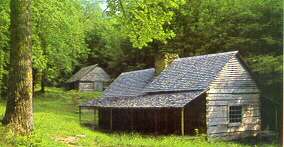Echoes From The Past
By JUDY MAUPIN
*- Echoes From the Past
(A Column of historical and genealogical anecdotes, stories and family notes.)
Calloway County, Ky.
George Brandon
September 8, 1979
In 1973, Carol Stockinger prepared an
Interesting history of the Brandon
Spring Group Camp, In Land Between theLakes. Itisagood sketch of the way the land was and how the people lived around 1800, when the area was settled. But more than this, Carol gives details of two of the earliest settlers - the Gatlins and the Brandons.
George Brandon was the father of Christopher Brandon. He was born in South Carolina, of English ancestry, It having been said that his family was "loyal to Charles I of England."
Brandon is also credited with being the first permanent settler of the portion of Stewart County which lies between the Cumberland and the Tennessee River.
He settled along the banks of the Cumberland, but evidently was dissatisfied there, because he later moved to the Tobaccoport area, and later down to Dover. A few years later, he and two of his sons moved over into Calloway County and settled near Blood River. -
Three of the original Brandon,
brothers had fled England after the death of King Charles I, migrating to Maryland where one brother died.
Another returned to England after Charles II ascended the throne. The third brother settled in Virginia; his descendants later moved to North and South Carolina. It was from this family that - George and Christopher descended. Christopher married Jane Simpson, the granddaughter of J. Lassiter, a Revolutionary soldier from Trlgg County. After her death he married Polly Skinner, one of several connections between the Skinners and the Brandons.
The Brandons were active in the
early activities of the settlement, serving on court proceedings and other trappings of "civilization." Christopher Brandon served at the Battle of New Orleans under Andrew Jackson. The Brandons must have had rather large land holdings because they were listed among the early slave holders, who were comparatively rare In an area which did not boast large enough
plantations to merit slave labor.
George Brandon received, according to one report, a female slave as a wedding
gift from his father In law in 1809.
Close by where the Brandon Springs Group Camp now stands was the location of the old Brandon homestead. The hoUse, built high on a hill
overlooking the Cumberland River, stood until shortly after WA purchased the land. It was originally built by Nathan Skinner about 1823. Built of poplar logs, the house stood two stories high (an unusual style for that time and area), with a veranda and columns across the front. It may be that Mr. Skinner had fried to reproduce a former home be had had before corning further north to Kentucky. There were six rooms, with a fireplace at either end, a large central hail and a steep stairway to the second floor and its three bedrooms. This house was used by Skinner as an impromptu river inn, where he rented overnight lodging to travelers on the river. It has been said that often these wayfarers never got any further; Skinner supposedly murdered them for their belongings and disposed of the remains In the dark of the night Skinner was also known to be a counterfeiter.
After the Civil War, the Skinner house, which by that time had passed into the Gathn family (about 1846), belonged to George Gatlln and his wife Lucinda. Both died there. Lucinda died in 1885 and is burled in the nearby Mount 7Aon Cemetery, on land donated by the Gatlln family for a church and cemetery. After George Gatlin's death, the house passed on to his daughter George Ann Brqndon, a widow with three young children.
The Brandons were regarded by their
neighbors as rather retiring, keeping themselves apart from others. George Brandon, son of George Ann Gatlin Brandon was a quiet, well dressed man
who had very little to say to others. Mrs. Brandon was evidently very much a homebody, content to care for her husband and children.
Their home was remembered as being a prime example of the matriarchal society. Vivian Brandon was a strong woman, very concerned about her family; it was said by Nathan Brandon that the two things she Insisted upon were a proper education for her children and all the health care they needed - which were enumerated by her as cod liver oil, a toothbrush, and
regular baths.
The Brandon farm was a self-contained community, raising or producing whatever they needed on the home place. The Brandons were frequently the recipients of family visitors, the Brandon farm being considered as a sort of vacation resort. George Brandon was an educated man, who taught at the school which was held In the Mount Zion church building. He had attended the Murray Institute, and was quite interested in "modern" farming methods as well as education. He was the first to purchase purebred cattle and hogs; It was said that when the no-fence law was being argued, he preferred to keep his livestock fenced, to keep the strain pure. He was later one of the first to introduce tractor power on the farm. The Brandon home later passed Into the hands of two of the Brandon children, after George Brandon's death in 1949. They remained there until the land was sold to make way for the Land Between the Lakes. But the Brandon name Is still kept with the land, In memory of the first Brandons to settle there.

